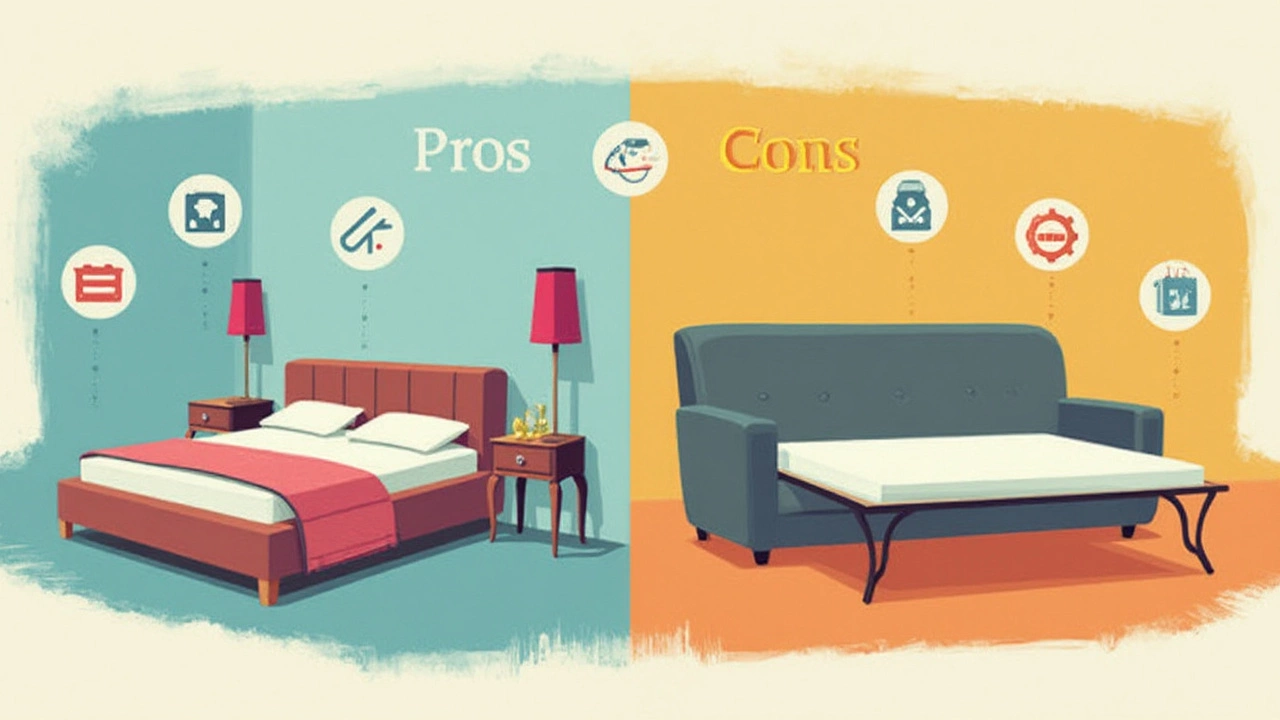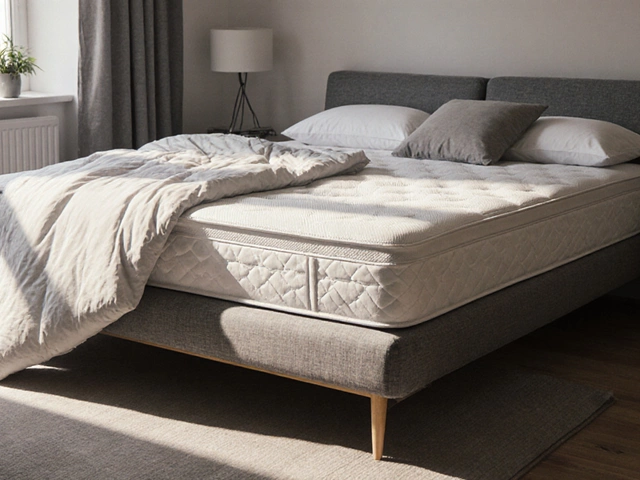 8
Jun,2025
8
Jun,2025
Ever wondered if you could ditch your regular bed and trust a sofa bed every night? You're not alone—especially if you live in a small apartment, have a home office, or just want more out of your living room. But there’s a big difference between a guest crashing for a weekend and you dealing with the thing every night.
Sofa beds come in all shapes, sizes, and price tags, but comfort really comes down to a few main things: the type of mattress, how the frame is built, and how easy it is to fold out (and back in, especially when you're half-awake). If you’ve slept on a cheap, saggy pull-out, you know the pain—literally. But the newer models? Some can rival actual beds if you know what to look for.
Let’s get real: not every sofa bed is meant for daily sleep. Many old-school models have thin, springy mattresses (think of those you find in grandma's basement). But some brands now use memory foam or hybrid mattresses specifically built for everyday use. Some even let you pick the mattress type, which is a game changer.
So before you commit, it pays to know which features matter, which shortcuts to avoid, and a couple of maintenance tricks. A little homework now can save your back—and your wallet—later.
- What Makes a Sofa Bed Comfortable?
- Daily Use: Pros and Cons
- Tips for Maximizing Comfort
- What to Watch Out For
What Makes a Sofa Bed Comfortable?
It's all about the basics: mattress type, frame design, and how the sofa bed sits when you actually use it. The main thing people complain about? Waking up with a sore back or feeling a metal bar poke through the mattress. So, let’s break down what actually separates a good sofa bed from a terrible one.
First, the mattress makes or breaks the deal. Memory foam and high-density foam mattresses are miles ahead of those old coil spring ones. Most high-end models today use at least 4 to 6 inches of quality foam, which is thick enough to even out those lumps and keep you from sinking to the frame. If you really want the best sofa bed comfort, look for options that offer a choice of mattress or at least let you upgrade it.
The frame matters just as much. Wood or sturdy steel frames last longer and creak less, plus they give support where you need it most. The pull-out mechanism also matters—a clunky or stiff one will drive you crazy after a week, so check for smooth operation at the store (or read every real customer review you can find).
Here are a few things to look for if you want real comfort night after night:
- Mattress thickness and type: Go for memory foam or a hybrid if possible. Thicker is usually better, but watch for models where the mattress folds neatly away.
- Frame support: Solid frames (not wobbly, not flimsy) help a ton with sleep quality.
- No center bar problems: The dreaded “bar in your back” is less common with newer designs. Test it out or look for reviews mentioning this before buying.
- Seat cushions: These matter if you sit a lot, too. Higher-resilience foam stays comfier and holds its shape longer.
- Breathable materials: Overheating happens more on plastic-feeling covers. Go for fabric or a mattress with a breathable cover.
If you want your sofa bed to feel close to a real bed, don’t settle for a thin, basic mattress or a weak frame. Investing a bit more upfront pays off with way better sleep and way fewer aches.
Daily Use: Pros and Cons
If you’re thinking about using a sofa bed every night, there are serious perks—and some real drawbacks. Let’s break it down for you, so you don’t end up with buyer’s remorse.
First off, space-saving is the big win. If your place is cramped or you want a living room that doubles as a bedroom, a sofa bed is basically two pieces of furniture in one. When you don’t need the bed, just fold it up and boom: you’ve got a couch for watching TV or getting work done.
Another plus is money. Buying a sofa bed comfort setup is often much cheaper than splurging on both a quality sofa and a full bed. Newer sofa beds even come with thick memory foam mattresses that are surprisingly decent for daily sleep. Some models ditch those old, painful metal bars and lumpy springs for solid platforms or hybrid designs. A popular study by the Sleep Foundation in 2023 even showed that newer sofa beds with memory foam got better sleep ratings (for short-term use) than the old innerspring kinds.
But let’s get to the flip side. Sleeping on a sofa bed every night can be rough if you pick the wrong model. Even the best ones sometimes sag after months of daily use. Frames can get creaky, and if the mattress is thin, you could start feeling the support bars—or lack of support—pretty quickly. If you have back issues or sensitive joints, this is something to think about.
More stuff to consider:
- Setup hassle: Pulling out the bed and putting it away every day can get old fast. It’s worse if it’s heavy or jammed.
- Wear and tear: Daily opening and closing can wear out the hinges, fabric, and springs faster than if you only used it for guests.
- Bedding storage: You’ll probably need somewhere to stash your pillows and blankets each morning.
- Size limits: Most sofa beds are only full or queen size, so couples used to a king might feel squeezed.
Bottom line? The pros can easily tip the scale if you find the right sofa bed and treat it well, but don’t expect it to feel exactly like your old bed. Pick carefully, and the tradeoffs might be totally worth it for your space and budget.

Tips for Maximizing Comfort
If you’re thinking about using a sofa bed as your main sleep setup, there are a few things you can do to seriously level up your comfort. You don’t have to just accept lumps, sagging, or a backache. Most folks who do this every night figure out some reliable hacks to make it work.
First up, get serious about the mattress. If your sofa bed came with one of those thin, bendy mattresses, know that you don’t have to settle. You can actually swap it for a memory foam or a latex-topped replacement—just double-check the size fits your frame. Some companies, like Classic Brands or Milliard, actually sell replacement sofa bed mattresses made for regular, nightly use. These are usually 4 to 5 inches thick, which is way better than the flat, springy ones most sofa beds come with.
Not ready to buy a new mattress? You can still improve things with a topper. A high-density foam or a gel memory foam topper flattens out bumps and adds cushion. Don’t skimp and get a cheap, super-thin topper—aim for at least two inches thick for real effect. Roll it up when you use the sofa as a couch.
- Pick up a mattress protector. Even good sofa bed mattresses can soak up sweat or dust over time, making them stink or wear out faster.
- Rotate the mattress and topper every couple of months. This helps prevent low spots where you naturally lay.
- Lay a blanket over the bars or any frame pieces under the mattress if you ever feel them. This old-school hack can stop sore spots popping up overnight.
- Try different bedding. Tightly fitted sheets and a soft, supportive pillow can make more difference than you think, especially if the mattress isn’t the thickest.
If you want your sofa bed comfort to last, pay attention to the mechanics, too. Don’t slam the frame when you fold it out or away—steel joints can bend, which makes the whole thing wonky and uncomfortable. Tighten loose bolts every few months, especially if you notice new squeaks or wobbles.
And finally, if you’re handy, you can actually reinforce the support slats under the mattress with plywood cut to fit the frame. A cheap hardware store fix, but lots of everyday sofa bed users say it totally knocks out the dreaded saggy gap in the middle.
Bottom line: you don’t have to just “put up with it.” With the right tweaks and a bit of regular care, you really can squeeze out every bit of comfort from your sofa bed—even if it’s your main spot, not just an occasional guest bed.
What to Watch Out For
If you're eyeing a sofa bed for everyday use, there's stuff people often overlook that can make or break your experience. Trust me, you don’t want to regret your purchase every time you unfold your bed.
First up: watch out for thin or cheap mattresses. A lot of sofa beds, especially sub-$500 models, come with mattresses barely three inches thick. That might cut it for a weekend guest, but you’ll feel the frame through the mattress in no time if you’re sleeping on it night after night. Experts say a mattress of at least 5 inches thick (memory foam or hybrid) holds up way better for sofa bed comfort and your back.
Then there’s frame construction. Wooden frames sound nice, but hardwood lasts longer than particle board or softwood. Metal frames are sturdy, but if they’re poorly welded, they creak like nobody’s business. Check for reinforced joints and solid center supports to prevent sagging. A lot of complaints online come from weak crossbars that poke right through over time.
Next, test the mechanism. If the pull-out or folding system feels stiff or jerky in the store, imagine wrangling with it every morning and night. Some mechanisms start off smooth but get shaky or misaligned after six months. Stick to well-reviewed models, and don’t be afraid to open and close the thing a few times while shopping.
Here’s a quick breakdown of common issues and how often people report them (based on user reviews and reliability ratings in 2024):
| Problem | Reported Frequency | Fix or Prevention |
|---|---|---|
| Uncomfortable mattress | 67% | Buy aftermarket mattress topper; choose thick memory foam |
| Frame squeaks/noise | 41% | Tighten bolts; lubricate joints |
| Sagging over time | 36% | Pick models with center support; avoid cheap frames |
| Tricky or stiff mechanism | 24% | Test before buying; look for reviews about longevity |
One more thing—look out for the gap where the mattress folds. Some sofa beds leave a dip right under your hips or shoulders. If you feel one in the store, it’ll only get worse at home. Some brands now make "creaseless" fold-outs, which are worth the extra cost if you’re using this daily.
Quick tip: check return policies. Sleeping on a sofa bed is different than just sitting on it for 10 minutes at the showroom. Make sure you can swap it out or return it if you find out it’s a no-go after a week of real use.
- Go for at least 5" of mattress thickness (preferably memory foam).
- Check for solid center support on the frame.
- Test the folding system several times before buying.
- Confirm the return/exchange policy to be safe.
Sofa beds have come a long way, but getting one that works every single night takes a little homework up front.




